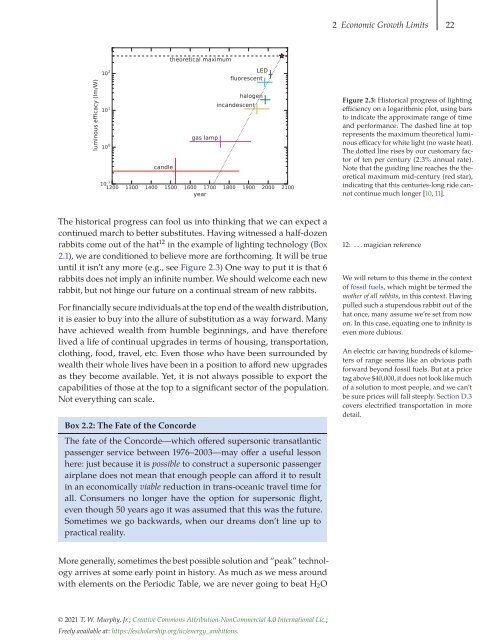Energy and Human Ambitions on a Finite Planet, 2021a
Energy and Human Ambitions on a Finite Planet, 2021a
Energy and Human Ambitions on a Finite Planet, 2021a
Create successful ePaper yourself
Turn your PDF publications into a flip-book with our unique Google optimized e-Paper software.
2 Ec<strong>on</strong>omic Growth Limits 22<br />
theoretical maximum<br />
luminous efficacy (lm/W)<br />
10 2<br />
10 1<br />
10 0<br />
c<str<strong>on</strong>g>and</str<strong>on</strong>g>le<br />
gas lamp<br />
LED<br />
fluorescent<br />
halogen<br />
inc<str<strong>on</strong>g>and</str<strong>on</strong>g>escent<br />
10 -1<br />
1200 1300 1400 1500 1600 1700 1800 1900 2000 2100<br />
year<br />
Figure 2.3: Historical progress of lighting<br />
efficiency <strong>on</strong> a logarithmic plot, using bars<br />
to indicate the approximate range of time<br />
<str<strong>on</strong>g>and</str<strong>on</strong>g> performance. The dashed line at top<br />
represents the maximum theoretical luminous<br />
efficacy for white light (no waste heat).<br />
The dotted line rises by our customary factor<br />
of ten per century (2.3% annual rate).<br />
Note that the guiding line reaches the theoretical<br />
maximum mid-century (red star),<br />
indicating that this centuries-l<strong>on</strong>g ride cannot<br />
c<strong>on</strong>tinue much l<strong>on</strong>ger [10, 11].<br />
The historical progress can fool us into thinking that we can expect a<br />
c<strong>on</strong>tinued march to better substitutes. Having witnessed a half-dozen<br />
rabbits come out of the hat 12 in the example of lighting technology (Box<br />
2.1), we are c<strong>on</strong>diti<strong>on</strong>ed to believe more are forthcoming. It will be true<br />
until it isn’t any more (e.g., see Figure 2.3) One way to put it is that 6<br />
rabbits does not imply an infinite number. We should welcome each new<br />
rabbit, but not hinge our future <strong>on</strong> a c<strong>on</strong>tinual stream of new rabbits.<br />
For financially secure individuals at the top end of the wealth distributi<strong>on</strong>,<br />
it is easier to buy into the allure of substituti<strong>on</strong> as a way forward. Many<br />
have achieved wealth from humble beginnings, <str<strong>on</strong>g>and</str<strong>on</strong>g> have therefore<br />
lived a life of c<strong>on</strong>tinual upgrades in terms of housing, transportati<strong>on</strong>,<br />
clothing, food, travel, etc. Even those who have been surrounded by<br />
wealth their whole lives have been in a positi<strong>on</strong> to afford new upgrades<br />
as they become available. Yet, it is not always possible to export the<br />
capabilities of those at the top to a significant sector of the populati<strong>on</strong>.<br />
Not everything can scale.<br />
Box 2.2: The Fate of the C<strong>on</strong>corde<br />
The fate of the C<strong>on</strong>corde—which offered supers<strong>on</strong>ic transatlantic<br />
passenger service between 1976–2003—may offer a useful less<strong>on</strong><br />
here: just because it is possible to c<strong>on</strong>struct a supers<strong>on</strong>ic passenger<br />
airplane does not mean that enough people can afford it to result<br />
in an ec<strong>on</strong>omically viable reducti<strong>on</strong> in trans-oceanic travel time for<br />
all. C<strong>on</strong>sumers no l<strong>on</strong>ger have the opti<strong>on</strong> for supers<strong>on</strong>ic flight,<br />
even though 50 years ago it was assumed that this was the future.<br />
Sometimes we go backwards, when our dreams d<strong>on</strong>’t line up to<br />
practical reality.<br />
12: . . . magician reference<br />
We will return to this theme in the c<strong>on</strong>text<br />
of fossil fuels, which might be termed the<br />
mother of all rabbits, in this c<strong>on</strong>text. Having<br />
pulled such a stupendous rabbit out of the<br />
hat <strong>on</strong>ce, many assume we’re set from now<br />
<strong>on</strong>. In this case, equating <strong>on</strong>e to infinity is<br />
even more dubious.<br />
An electric car having hundreds of kilometers<br />
of range seems like an obvious path<br />
forward bey<strong>on</strong>d fossil fuels. But at a price<br />
tag above $40,000, it does not look like much<br />
of a soluti<strong>on</strong> to most people, <str<strong>on</strong>g>and</str<strong>on</strong>g> we can’t<br />
be sure prices will fall steeply. Secti<strong>on</strong> D.3<br />
covers electrified transportati<strong>on</strong> in more<br />
detail.<br />
More generally, sometimes the best possible soluti<strong>on</strong> <str<strong>on</strong>g>and</str<strong>on</strong>g> “peak” technology<br />
arrives at some early point in history. As much as we mess around<br />
with elements <strong>on</strong> the Periodic Table, we are never going to beat H 2 O<br />
© 2021 T. W. Murphy, Jr.; Creative Comm<strong>on</strong>s Attributi<strong>on</strong>-N<strong>on</strong>Commercial 4.0 Internati<strong>on</strong>al Lic.;<br />
Freely available at: https://escholarship.org/uc/energy_ambiti<strong>on</strong>s.


















